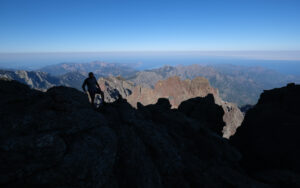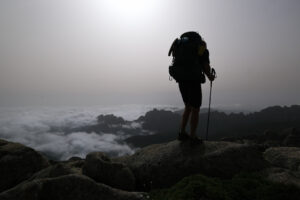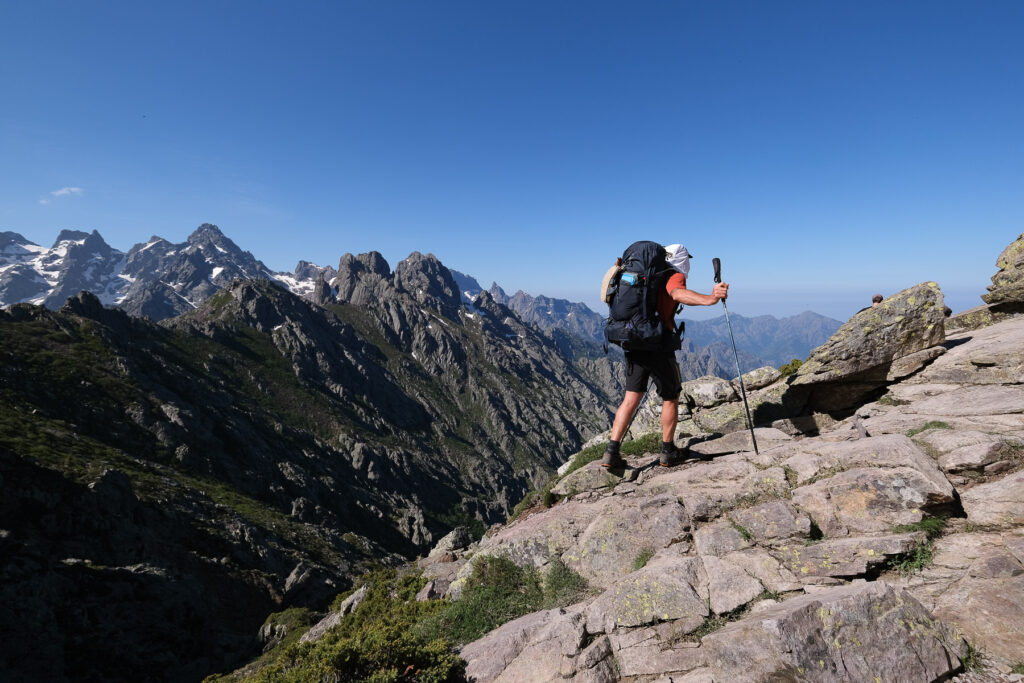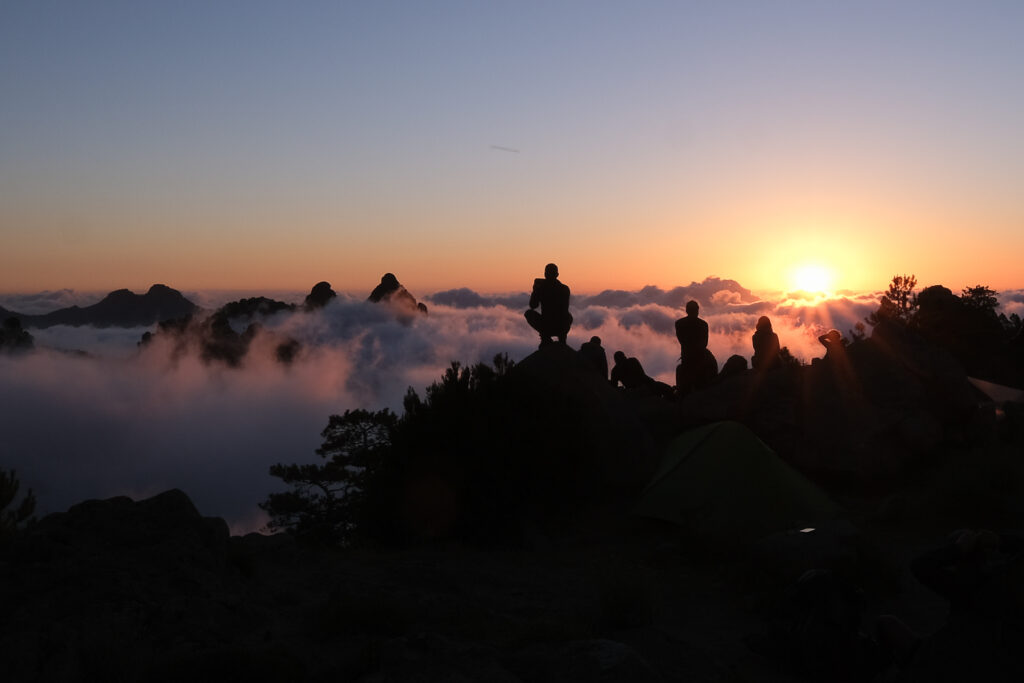TOPO
The GR20 and its variants
A classic among classics, the GR20 offers an exceptional itinerary for crossing Corsica from north to south, or vice versa, between sea and high mountains. With more than 160 kilometers of trails and over 12,000 meters of ascent, often between 1,500 and 2,500 meters above sea level, this is a challenging route for experienced hikers. But the GR20 is paying the price for its success, and for a little escape, we offer an alternative itinerary with numerous official and unofficial variants, and the ascent of some interesting peaks: Cirque de la Solitude, Paglia Orba and Capo Tafunatu, Monte d'Oro, Monte Renoso, Monte Incudine. This topo presents the GR20 as we did it in general terms, all the stages being described in more detail in the following posts.

Technical summary
The technical data corresponds to the itinerary we have chosen, with its variants and the ascent of several Corsican peaks.
Type ✦ Alpine touring hike
Location ✦ Calenzana to Conca
Region ✦ Corsica
Country ✦ France
Period ✦ June 10 to 22, 2021
Snow cover ✦ névés in the north, stages 3, 4 and 7
Max altitude ✦ 2525m
Total distance ✦ 164.6 km
Total positive vertical drop ✦ 12,110 m
Difficulty ✦ E5 / T4 / R5
Equipment ✦ crampons, 20m safety rope
Duration ✦ 78 hours of hiking in 13 days
Interest ✦ ★★★
Access to the place
If you decide to do the GR20 north-south, you'll need to get to Calenzana, 14 km south of Calvi. Arriving by ferry at Île Rousse, we took a small train to Calvi and from there a cab that dropped us off at Calenzana (€40 in 2021). From the south, the departure village is Conca, some 30 km north of Porto-Vecchio. Shuttles run daily from Porto-Vecchio to the start of the GR20.
Itinerary description
Hiking to the start
Arriving in Calenzana, head for the village center, where you'll soon find signs indicating the start of the GR20. Cross it and finally exit to the south on the red-and-white-marked path, the start of the 160-kilometre route!
Course
The GR20 comprises 2 sections: the steeper, more alpine northern section from Calenzana to Vizzavona, and the gentler, more open southern section from Vizzavona to Conca. Here's a selection of the itineraries and stages we followed.
For each stage, you'll find :
■ distance in kilometers
■ positive and negative altitude differences in meters (d+ and d-)
■ the highest point of the stage (alt max)
■ our walking time without breaks
These data are indicative and may vary slightly due to certain off-trail or unmarked sections on the base maps.
Our aim was not to do the GR20 in a certain number of stages, but to choose the itineraries that seemed the most beautiful or interesting to cover, hence the choice of alpine variants, ridges or summits. Some of these choices led us to "double" official stages, often because the chosen itinerary was more direct, and therefore covered less distance but sometimes more altitude. We also avoided ending our days exhausted by too much walking, so that we could take in the sights, swim and admire the scenery each day.
GR20 North
Stage 1: Calenzana to refuge d'Ortu di u Piobbu (11.1 km, 1440 m d+, 135 m d-, alt max 1615 m, 5 hours)
Stage 2: Refuge d'Ortu di u Piobbu to refuge de Carrozu (7.4 km, 640 m d+, 910 m d-, alt max 2025 m, 5 hours)
Stage 3: Refuge de Carrozu to refuge d'Asco-Stagnu (4.9 km, 775 m d+, 620 m d-, alt max 1980 m, 4 hours)
Topo of stages 1, 2 and 3
Stage 4: Refuge d'Asco-Stagnu to refuge de Ciuttulu di i Mori via Cirque de la Solitude (13 km, 1625 m d+, 1060 m d-, alt max 2205 m, 8 hours 30)
Stage 5: Ciuttulu di i Mori refuge to Castellu di Vergio via Paglia Orba and Capo Tafunatu (12 km, 700 m d+, 1290 m d-, alt max 2525m, 6 hours)
Topo of stages 4 and 5
Stage 6: Castellu di Vergio to Manganu refuge (15.8 km, 610 m d+, 420 m d-, alt max 1870 m, 4 hours 30)
Stage 7: Refuge de Maganu to refuge de l'Onda via Pointe de Pinzi Corbini and Punta di l'Altore (14.7 km, 1135 m d+, 1325 m d-, alt max 2210 m, 7 hours)
Stage 8: Refuge de l'Onda to Vizzavona via Monte d'Oro (11 kms, 945 m d+, 1430 m d-, alt max 2389 m, 7 hours)
Topo of stages 6, 7 and 8
Total: 89.9 km, 7870 m d+, 7190 m d-, 47 hours
GR20 South
Stage 9: Vizzavona to Col de Verde via Punta Dell'Oriente and Monte Renoso (17.8 km, 1235 m d+, 1110 m d- alt max 2352 m, 8 hours 30)
Stage 10: Col de Verde to Usciolu hut (15.6 km, 1210 m d+, 750 m d-, alt max 1980 m, 7 hours)
Topo of stages 9 and 10
Stage 11: Refuge d'Usciulu to refuge d'Asinau via Monte Incudine (16.3 km, 870 m d+, 1080 m d-, alt max 2134 m, 6 hours)
Stage 12: Refuge d'Asinau to refuge d'i Paliri via the Bavella alpine variant (11.7 km, 600 m d+, 1090 m d-, alt max 1675 m, 5 hours)
Stage 13: Paliri hut to Conca (13.3 km, 325 m d+, 1130 m d-, alt max 1050 m, 3 hours 30)
Topo of stages 11, 12 and 13
Total: 74.7 km, 4240 m d+, 5160 m d-, 30 hours
Total GR20 and variants: 164.6 km, 12,110 m d+, 12,350 m d-, 77 hours
Equipment & gear
On the GR20, red and white markings are permanent and generally excellent. It's difficult to get lost, although there are sections where you need to be careful, especially if visibility is poor. On the official stages, there are also a few passages equipped with rungs or chains, but very few.
As far as technical equipment is concerned, a pair of light crampons is essential at this time of year, at least, and a small 20m safety rope if necessary. An ice-axe, on the other hand, is not essential, but may provide some reassurance.
As for the bag and its weight, this of course depends on whether you choose to sleep in a dormitory, a PNRC tent or your own tent, and on whether you choose to eat at the refuge or manage some or all of your meals on your own. We left with our tent (for 2), a small stove and freeze-dried food for lunch, and including the day's water, we were between 16 and 18 kg. If you take other options, you can reasonably reduce your pack to 13 or 14 kg.
Bear in mind, however, that we're talking about high mountains, and that it's imperative to have warm, rainproof clothing, as well as the maps you need to know where you are and how far you have to go. In this respect, it's probably best to have a GPS track of the entire route loaded on your cell phone, so that you can locate yourself at any time if you need to (KLM file on MapsMe, for example, or GPX file on Iphygénie). This is particularly useful on unofficial variants and off-trail passages.
Difficulty
The GR20 is designed for experienced and trained hikers, particularly in the north, where there are long, exposed and very uneven sections where you need to use your hands to progress (no II or III). Taking into account the weight of the rucksack and the fatigue that will accumulate, mountain experience seems essential to enjoy yourself all the way and not put yourself in danger.
In June, there are stages with a few passages on névé which require a pair of crampons to avoid getting scared, even if often the tracks are made and the progression is facilitated.
To cover the variants and summits we propose here, the difficulty increases, with at times the absence of markings and even off-trail sections requiring good orientation skills and an ability to find alpine routes. These options also include more delicate passages to negotiate, climb or de-climb, and long exposed sections where falling is forbidden. They are therefore aimed at people who are used to this type of autonomous progression at altitude.
The refuges
Bivouacs are forbidden in the Parc Régional Naturel de Corse (PNRC), except in emergencies. Nights are therefore spent in a refuge, either in a dormitory or in our own tent, an option we chose for greater autonomy. The price in June 2021 was 7€ per person to bivouac with your own tent at the refuge (price with reservation on the park website, 12€ if no reservation).
The PNRC refuges we stopped at were very uneven in all respects: welcome, cleanliness, meals, location, comfort, sanitary facilities, food. Cold or hot showers, basic toilets to dry toilets, basic or even minimal meals to good little cooked dishes, a cold or even paleolithic welcome to warm and inviting, sloping terrain with pebbles to terraces, more or less consistent food supplies. It all seems to depend on the managers, who may or may not want to emphasize this or that aspect of the refuge.
There are also Bergeries (not tested) and private refuges along the way, where you can also bivouac and eat: for example, the Castellu di Vergio campsite, the Vizzavona and Col de Verde refuges, with services that are generally superior to the park's refuges for almost the same price (in 2021).
The price of meals and refreshments is rather high (evening meals between €18 and €24 in 2021), often without the quality of the service, apart from a few exceptions. Recharging batteries or telephones also costs €1 or €2, depending on the hut, unless you carry a self-contained solar panel.
Back
Once in Conca, go to the GR20 bar, from where shuttles leave for Port-Vecchio (€6.50 in 2021). In June, shuttles run on request, in July and August on a regular schedule. Information at the GR20 bar in Conca.

















































Leave a Reply